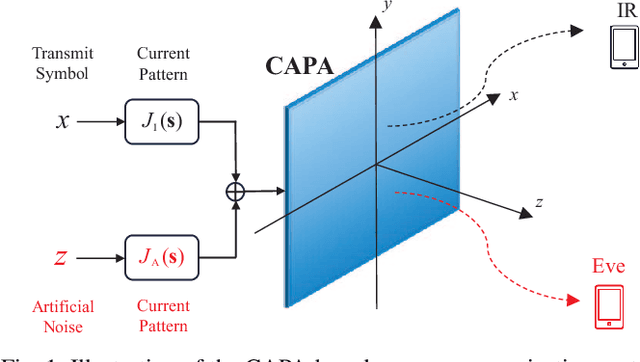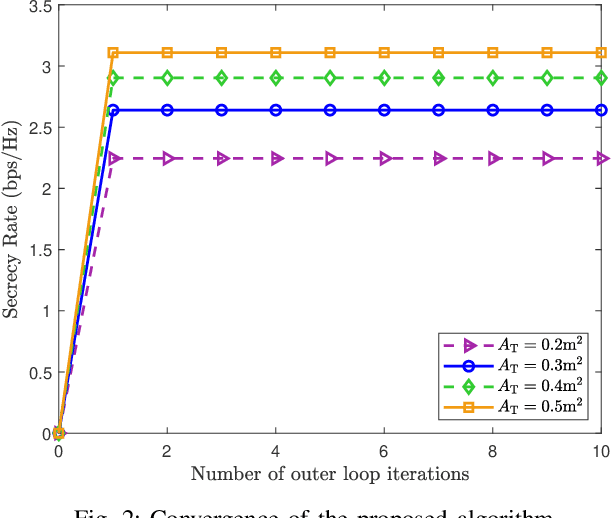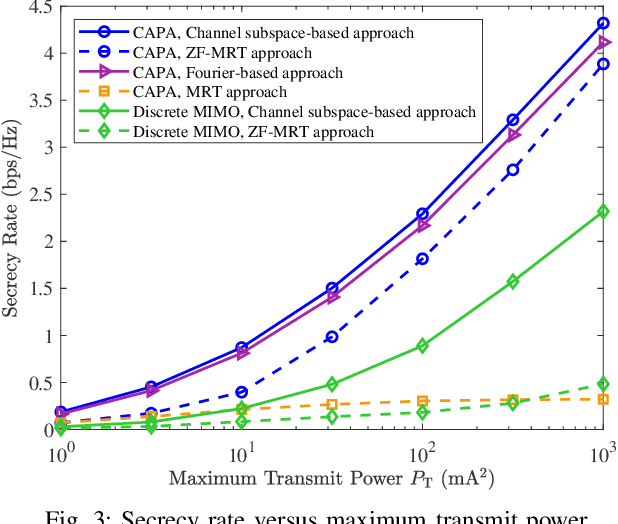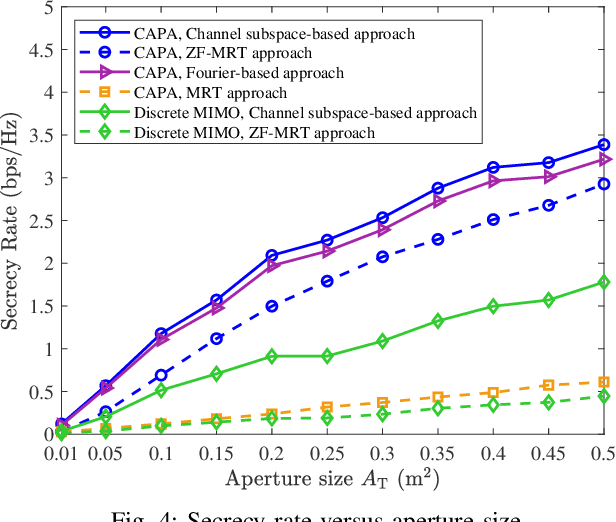Xidong Mu
PASS-Enhanced MEC: Joint Optimization of Task Offloading and Uplink PASS Beamforming
Oct 27, 2025Abstract:A pinching-antenna system (PASS)-enhanced mobile edge computing (MEC) architecture is investigated to improve the task offloading efficiency and latency performance in dynamic wireless environments. By leveraging dielectric waveguides and flexibly adjustable pinching antennas, PASS establishes short-distance line-of-sight (LoS) links while effectively mitigating the significant path loss and potential signal blockage, making it a promising solution for high-frequency MEC systems. We formulate a network latency minimization problem to joint optimize uplink PASS beamforming and task offloading. The resulting problem is modeled as a Markov decision process (MDP) and solved via the deep reinforcement learning (DRL) method. To address the instability introduced by the $\max$ operator in the objective function, we propose a load balancing-aware proximal policy optimization (LBPPO) algorithm. LBPPO incorporates both node-level and waveguide-level load balancing information into the policy design, maintaining computational and transmission delay equilibrium, respectively. Simulation results demonstrate that the proposed PASS-enhanced MEC with adaptive uplink PASS beamforming exhibit stronger convergence capability than fixed-PA baselines and conventional MIMO-assisted MEC, especially in scenarios with a large number of UEs or high transmit power.
Pinching-Antenna Systems-Enabled Multi-User Communications: Transmission Structures and Beamforming Optimization
Aug 20, 2025Abstract:Pinching-antenna systems (PASS) represent an innovative advancement in flexible-antenna technologies, aimed at significantly improving wireless communications by ensuring reliable line-of-sight connections and dynamic antenna array reconfigurations. To employ multi-waveguide PASS in multi-user communications, three practical transmission structures are proposed, namely waveguide multiplexing (WM), waveguide division (WD), and waveguide switching (WS). Based on the proposed structures, the joint baseband signal processing and pinching beamforming design is studied for a general multi-group multicast communication system, with the unicast communication encompassed as a special case. A max-min fairness problem is formulated for each proposed transmission structure, subject to the maximum transmit power constraint. For WM, to solve the highly-coupled and non-convex MMF problem with complex exponential and fractional expressions, a penalty dual decomposition (PDD)-based algorithm is invoked for obtaining locally optimal solutions. Specifically, the augmented Lagrangian relaxation is first applied to alleviate the stringent coupling constraints, which is followed by the block decomposition over the resulting augmented Lagrangian function. Then, the proposed PDD-based algorithm is extended to solve the MMF problem for both WD and WS. Furthermore, a low-complexity algorithm is proposed for the unicast case employing the WS structure, by simultaneously aligning the signal phases and minimizing the large-scale path loss at each user. Finally, numerical results reveal that: 1) the MMF performance is significantly improved by employing the PASS compared to conventional fixed-position antenna systems; 2) WS and WM are suitable for unicast and multicast communications, respectively; 3) the performance gap between WD and WM can be significantly alleviated when the users are geographically isolated.
Pinching-Antenna Systems (PASS): A Tutorial
Aug 11, 2025Abstract:Pinching antenna systems (PASS) present a breakthrough among the flexible-antenna technologies, and distinguish themselves by facilitating large-scale antenna reconfiguration, line-of-sight creation, scalable implementation, and near-field benefits, thus bringing wireless communications from the last mile to the last meter. A comprehensive tutorial is presented in this paper. First, the fundamentals of PASS are discussed, including PASS signal models, hardware models, power radiation models, and pinching antenna activation methods. Building upon this, the information-theoretic capacity limits achieved by PASS are characterized, and several typical performance metrics of PASS-based communications are analyzed to demonstrate its superiority over conventional antenna technologies. Next, the pinching beamforming design is investigated. The corresponding power scaling law is first characterized. For the joint transmit and pinching design in the general multiple-waveguide case, 1) a pair of transmission strategies is proposed for PASS-based single-user communications to validate the superiority of PASS, namely sub-connected and fully connected structures; and 2) three practical protocols are proposed for facilitating PASS-based multi-user communications, namely waveguide switching, waveguide division, and waveguide multiplexing. A possible implementation of PASS in wideband communications is further highlighted. Moreover, the channel state information acquisition in PASS is elaborated with a pair of promising solutions. To overcome the high complexity and suboptimality inherent in conventional convex-optimization-based approaches, machine-learning-based methods for operating PASS are also explored, focusing on selected deep neural network architectures and training algorithms. Finally, several promising applications of PASS in next-generation wireless networks are highlighted.
Pinching-Antenna Systems (PASS) Meet Multiple Access: NOMA or OMA?
Jun 16, 2025Abstract:A fundamental two-user PASS-based communication system is considered under three MA schemes, namely non-orthogonal multiple access (NOMA), frequency division multiple access (FDMA), and time division multiple access (TDMA). For each MA scheme, a pinching beamforming optimization problem is formulated to minimize the required transmit power for satisfying users' rate requirements. For NOMA and FDMA, a two-stage algorithm is proposed, where the locations of PAs are derived sequentially by using the successive convex approximation (SCA) method and fine-turning phase adjustment. For TDMA, by leveraging the time-switching feature of PASS, the optimal pinching beamforming of each time slot is derived to maximize the served user channel gain. Numerical results are provided to show that: 1) PASS can achieve a significant performance gain over conventional antenna systems, and 2) NOMA consistently outperforms FDMA, while TDMA provides superior performance than NOMA for symmetric user rate requirements.
Movable-Element STARS-Assisted Near-Field Wideband Communications
May 25, 2025Abstract:A novel movable-element simultaneously transmitting and reflecting surface (ME-STARS)-assisted near-field wideband communication framework is proposed. In particular, the position of each STARS element can be adjusted to combat the significant wideband beam squint issue in the near field instead of using costly true-time delay components. Four practical ME-STARS element movement modes are proposed, namely region-based (RB), horizontal-based (HB), vertical-based (VB), and diagonal-based (DB) modes. Based on this, a near-field wideband multi-user downlink communication scenario is considered, where a sum rate maximization problem is formulated by jointly optimizing the base station (BS) precoding, ME-STARS beamforming, and element positions. To solve this intractable problem, a two-layer algorithm is developed. For the inner layer, the block coordinate descent optimization framework is utilized to solve the BS precoding and ME-STARS beamforming in an iterative manner. For the outer layer, the particle swarm optimization-based heuristic search method is employed to determine the desired element positions. Numerical results show that:1) the ME-STARSs can effectively address the beam squint for near-field wideband communications compared to conventional STARSs with fixed element positions; 2) the RB mode achieves the most efficient beam squint effect mitigation, while the DB mode achieves the best trade-off between performance gain and hardware overhead; and 3) an increase in the number of ME-STARS elements or BS subcarriers substantially improves the system performance.
Spectral Efficiency Analysis of Near-Field Holographic MIMO over Ricean Fading Channels
May 02, 2025



Abstract:With the denser distribution of antenna elements, stronger mutual coupling effects would kick in among antenna elements, which would eventually affect the communication performance. Meanwhile, as the holographic array usually has large physical size, the possibility of near-field communication increases. This paper investigates a near-field multi-user downlink HMIMO system and characterizes the spectral efficiency (SE) under the mutual coupling effect over Ricean fading channels. Both perfect and imperfect channel state information (CSI) scenarios are considered. (i) For the perfect CSI case, the mutual coupling and radiation efficiency model are first established. Then, the closed-form SE is derived under maximum ratio transmission (MRT). By comparing the SE between the cases with and without mutual coupling, it is unveiled that the system SE with mutual coupling might outperform that without mutual coupling in the low transmit power regime for a given aperture size. Moreover, it is also unveiled that the inter-user interference cannot be eliminated unless the physical size of the array increases to infinity. Fortunately, the additional distance term in the near-field channel can be exploited for the inter-user interference mitigation, especially for the worst case, where the users' angular positions overlap to a great extent. (ii) For the imperfect CSI case, the channel estimation error is considered for the derivation of the closed-form SE under MRT. It shows that in the low transmit power regime, the system SE can be enhanced by increasing the pilot power and the antenna element density, the latter of which will lead to severe mutual coupling. In the high transmit power regime, increasing the pilot power has a limited effect on improving the system SE. However, increasing the antenna element density remains highly beneficial for enhancing the system SE.
Continuous Aperture Array (CAPA)-Based Multi-Group Multicast Communications
May 02, 2025Abstract:A continuous aperture array (CAPA)-based multi-group multicast communication system is investigated. An integral-based CAPA multi-group multicast beamforming design is formulated for the maximization of the system energy efficiency (EE), subject to a minimum multicast SE constraint of each user group and a total transmit power constraint. To address this non-econvex fractional programming problem, the Dinkelbach's method is employed. Within the Dinkelbach's framework, the non-convex group-wise multicast spectral efficiency (SE) constraint is first equivalently transformed into a tractable form with auxiliary variables. Then, an efficient block coordinate descent (BCD)-based algorithm is developed to solve the reformulated problem. The CAPA beamforming design subproblem can be optimally solved via the Lagrangian dual method and the calculus of variations (CoV) theory. It reveals that the optimal CAPA beamformer should be a combination of all the groups' user channels. To further reduce the computational complexity, a low-complexity zero-forcing (ZF)-based approach is proposed. The closed-form ZF CAPA beamformer is derived using each group's most representative user channel to mitigate the inter-group interference while ensuring the intra-group multicast performance. Then, the beamforming design subproblem in the BCD-based algorithm becomes a convex power allocation subproblem, which can be efficiently solved. Numerical results demonstrate that 1) the CAPA can significantly improve the EE compared to conventional spatially discrete arrays (SPDAs); 2) due to the enhanced spatial resolutions, increasing the aperture size of CAPA is not always beneficial for EE enhancement in multicast scenarios; and 3) wider user distributions of each group cause a significant EE degradation of CAPA compared to SPDA.
Pinching-Antenna Systems (PASS): Power Radiation Model and Optimal Beamforming Design
Apr 30, 2025Abstract:Pinching-antenna systems (PASS) improve wireless links by configuring the locations of activated pinching antennas along dielectric waveguides, namely pinching beamforming. In this paper, a novel adjustable power radiation model is proposed for PASS, where power radiation ratios of pinching antennas can be flexibly controlled by tuning the spacing between pinching antennas and waveguides. A closed-form pinching antenna spacing arrangement strategy is derived to achieve the commonly assumed equal-power radiation. Based on this, a practical PASS framework relying on discrete activation is considered, where pinching antennas can only be activated among a set of predefined locations. A transmit power minimization problem is formulated, which jointly optimizes the transmit beamforming, pinching beamforming, and the numbers of activated pinching antennas, subject to each user's minimum rate requirement. (1) To solve the resulting highly coupled mixed-integer nonlinear programming (MINLP) problem, branch-and-bound (BnB)-based algorithms are proposed for both single-user and multi-user scenarios, which is guaranteed to converge to globally optimal solutions. (2) A low-complexity many-to-many matching algorithm is further developed. Combined with the Karush-Kuhn-Tucker (KKT) theory, locally optimal and pairwise-stable solutions are obtained within polynomial-time complexity. Simulation results demonstrate that: (i) PASS significantly outperforms conventional multi-antenna architectures, particularly when the number of users and the spatial range increase; and (ii) The proposed matching-based algorithm achieves near-optimal performance, resulting in only a slight performance loss while significantly reducing computational overheads. Code is available at https://github.com/xiaoxiaxusummer/PASS_Discrete
Pinching-Antenna Systems (PASS)-enabled Secure Wireless Communications
Apr 18, 2025Abstract:A novel pinching-antenna systems (PASS)-enabled secure wireless communication framework is proposed. By dynamically adjusting the positions of dielectric particles, namely pinching antennas (PAs), along the waveguides, PASS introduces a novel concept of pinching beamforming to enhance the performance of physical layer security. A fundamental PASS-enabled secure communication system is considered with one legitimate user and one eavesdropper. Both single-waveguide and multiple-waveguide scenarios are studied. 1) For the single-waveguide scenario, the secrecy rate (SR) maximization is formulated to optimize the pinching beamforming. A PA-wise successive tuning (PAST) algorithm is proposed, which ensures constructive signal superposition at the legitimate user while inducing a destructive legitimate signal at the eavesdropper. 2) For the multiple-waveguide scenario, artificial noise (AN) is employed to further improve secrecy performance. A pair of practical transmission architectures are developed: waveguide division (WD) and waveguide multiplexing (WM). The key difference lies in whether each waveguide carries a single type of signal or a mixture of signals with baseband beamforming. For the SR maximization problem under the WD case, a two-stage algorithm is developed, where the pinching beamforming is designed with the PAST algorithm and the baseband power allocation among AN and legitimate signals is solved using successive convex approximation (SCA). For the WM case, an alternating optimization algorithm is developed, where the baseband beamforming is optimized with SCA and the pinching beamforming is designed employing particle swarm optimization.
Continuous Aperture Array (CAPA)-Based Secure Wireless Communications
Apr 15, 2025



Abstract:A continuous aperture array (CAPA)-based secure communication system is investigated, where a base station equipped with a CAPA transmits signals to a legitimate user under the existence of an eavesdropper. For improving the secrecy performance, the artificial noise (AN) is employed at the BS for the jamming purpose. We aim at maximizing the secrecy rate by jointly optimizing the information-bearing and AN source current patterns, subject to the maximum transmit power constraint. To solve the resultant non-convex integral-based functional programming problem, a channel subspace-based approach is first proposed via exploiting the result that the optimal current patterns always lie within the subspace spanned by all users' channel responses. Then, the intractable CAPA continuous source current pattern design problem with an infinite number of optimization variables is equivalently transformed into the channel-subspace weighting factor optimization problem with a finite number of optimization variables. A penalty-based successive convex approximation method is developed for iteratively optimizing the finite-size weighting vectors. To further reduce the computational complexity, we propose a two-stage source current patterns design scheme. Specifically, the information-bearing and AN patterns are first designed using the maximal ration transmission and zero-forcing transmission, respectively. Then, the remaining power allocation is addressed via the one-dimensional search method. Numerical results unveil that 1) the CAPA brings in significant secrecy rate gain compared to the conventional discrete multiple-input multiple-output; 2) the proposed channel subspace-based algorithm outperforms the conventional Fourier-based approach, while sustaining much lower computational complexity; and 3) the two-stage ZF-MRT approach has negligible performance loss for the large transmit power regime.
 Add to Chrome
Add to Chrome Add to Firefox
Add to Firefox Add to Edge
Add to Edge